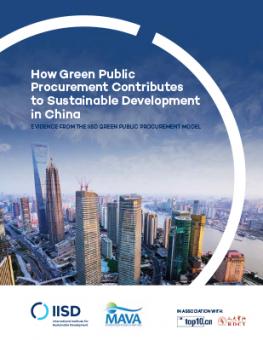
How Green Public Procurement Contributes to Sustainable Development in China
Building on the results of the IISD Green Public Procurement (GPP) Model, consultations with stakeholders and an extensive literature review, this paper provides targeted recommendations addressing the development areas identified to improve GPP in China.
Building on the results of the IISD Green Public Procurement (GPP) Model, consultations with stakeholders and an extensive literature review, this paper provides targeted recommendations addressing the development areas identified to improve GPP in China.
The recommendations follow a multiphase approach offering more immediate solutions as well as more ambitious, larger-scale overhauls of the GPP framework for the long term.
The results of the IISD GPP Model are discussed in detail, making the case for green procurement through analyzing five product categories: air conditioners, lighting, cars, paper and cement. These categories were selected because they represent significant financial flows in procurement, have notable environmental impacts and domestic production, and have sufficient data available to facilitate their analysis. A detailed overview of the key elements of the modelling approach will be provided, in addition to an explanation of the model setup and the range of externalities monetized for each product category. Finally, we will look at how to use the model at the different levels of government as well as how its scope can be extended and customized in order to leverage its potential under a wider range of circumstances and areas of procurement.
Participating experts
Additional downloads
You might also be interested in
Green Public Procurement in China: Quantifying the benefits (Discussion Paper)
Financing Models for Soil Remediation in China
This report examines seven different types of soil remediation projects in China and provides a "state-of-play" survey of financing models for soil rehabilitation in China.
Green Public Procurement in India
This report analyzes the status of green public procurement (GPP) in India and suggests key strategies for advancing sustainable procurement practices.
The Role of Multilateral Development Banks for Low-Carbon Procurement in the Infrastructure Sector
This report examines the critical role of multilateral development banks (MDBs) in advancing low-carbon procurement within the infrastructure sector.